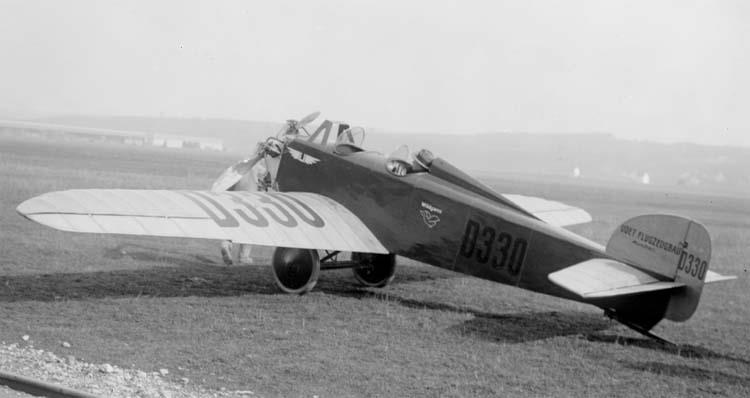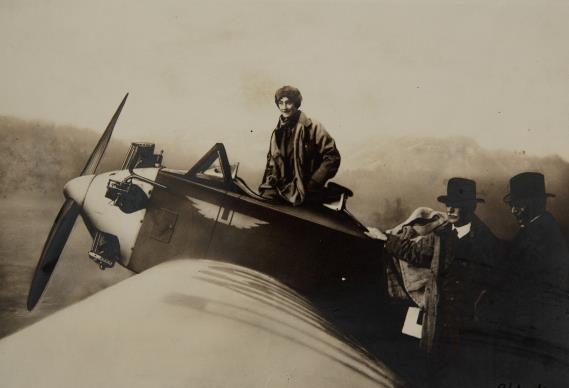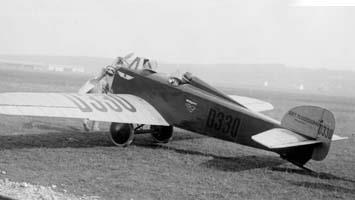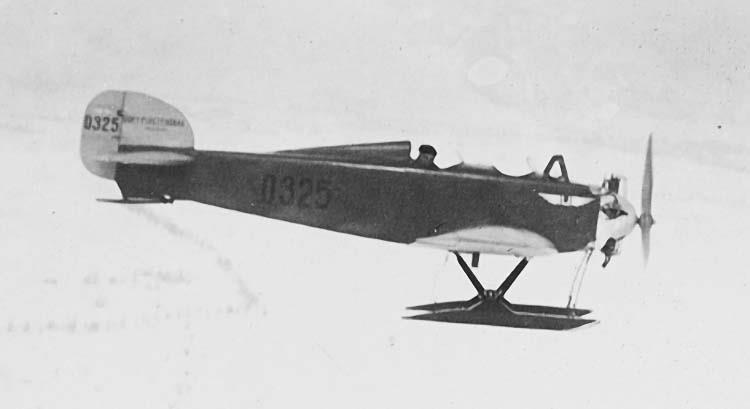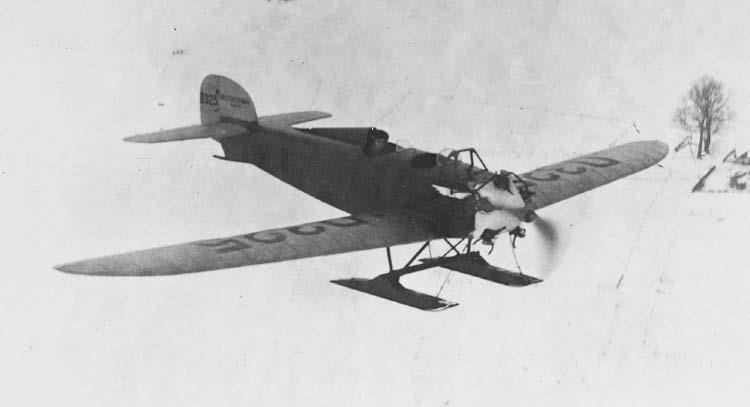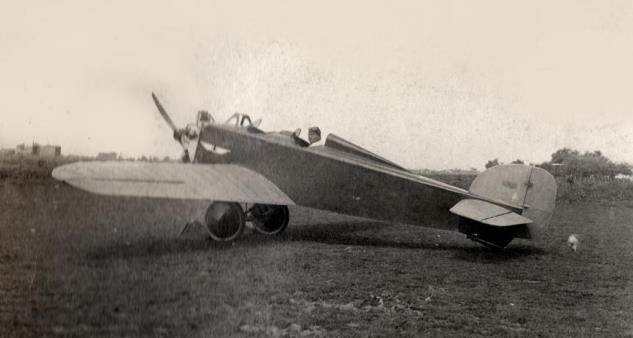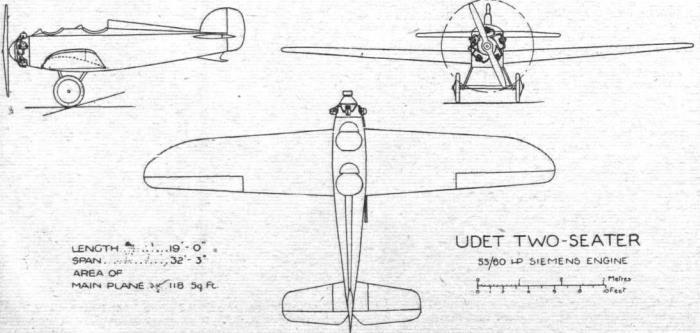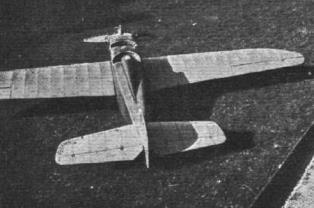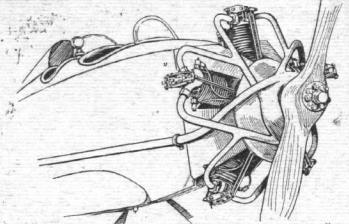From the accompanying illustrations it will be seen that the new Udet two-seater monoplane is of rather more pleasing appearance
than was the older type. The long, straight lines and small radii of wing and control surfaces have been replaced by shorter straight
lines and larger radii, with the result that the lines look better, quite apart from the fact that they probably are better aerodynamically.
Another change which helps to improve the appearance is that the two occupants are now installed in two separate cockpits in place
of the large common cockpit of the previous type.
Constructionally the new Udet follows the methods already established. The fuselage is plywood covered over a light wooden framework,
and the wing has two box spars of large dimensions (The wing being fairley thick in proportion to the chord). Although the monoplane
wing possesses a large diledral angle, it is built in one piece, the spars resting in notches cut in the lower part of the fuselage, and located by four bolts. In order to remove the wing, the machine is placed on trestles, and the rear undercarriage struts are cast off quick-release attachments being provided when the wing bolts can be undone and the wing dropped out of its notches.
The Siemens radial engine is neatly cowled-in, and a somewhat elaborate arrangement has been adopted for the exhaust collector ring. As the accompanying sketch shows, the exhaust pipes (there is but one exhaust valve per cylinder, although the valve cage is fitted with two ports) are welded up into the form of a letter Y, the foot of the letter being taken into the exhaust collector ring tangentially. A single long exhaust pipe on the starboard side carries the gases back clear of the pilot. The object of the arrangement evidently is to give the exhaust gases a circular movement inside the collector, from which they are then flung off tangentially through the pipe. Whether or not the arrangement does in fact produce this result we do not know. As a piece of welding the apparatus must be somewhat tricky, although the Germans are, of course, experts where oxy-acetylene welding is concerned. Whatever the effect on the engine of this exhaust arrangement, there is little doubt that it does keep the machine clean, and in this respect the Udet must be in marked contrast to the majority of the other German machines exhibited, which have in most cases merely short exhaust pipes, a few inches long, from each cylinder, and must necessarily throw back a lot of dirty oil on to the machine and occupants.
The undercarriage, as in previous Udet machines, is fairly high so as to give a large angle of incidence when the machine is standing on the ground, thus giving a quick pull-up on landing. This precaution is probably necessary on account of the high wing loading employed (9.8 lbs. per sq. ft.), which seems unnecessarily heavy for a sporting type of machine. The Udet 1923 tvpe monoplane two-seater has an overall length of 5,9 m. (19 ft. 4 ins), a span of 9,8 m. (32 ft. 1 in.), and a height over fuselage fairing of 1,95 m. (6 ft. 5 ins.). The wing area is approximately 118 sq. ft., including ailerons. The empty weight of the machine is 300 kgs. (660 lbs.) and the permissible useful load is 225 kgs. (500 lbs.), giving a total loaded weight of 525 kgs. (1,160 lbs.). The speed is stated to be 150 km/h. (93 m.p.h.). Sufficient fuel can be carried for a duration of five hours' flying.
| Type |
Two seated sportplane |
a Two seated sportplane (Export version) |
| Engine |
1 Siemens & Halske Sh 4 |
| Dimensions |
Length 5.85 m, span 8.90 m |
| Weights |
Empty 300 kg, fuel 65 kg, load 220 kg, flying weight 520 kg |
| Performance |
Max. speed at sea level 160 km/h, cruising speed at 2000 m 150 km/h, climb to 1000 m 6 min., service ceiling 3900 m, endurance 3.5 h |
| Type |
Werk.Nr |
Registration |
History |
| A |
A |
D-487 |
A |
|
|
D-325 |
|
|
|
D-330 |
"Wildgans" |
|
|
D-487 |
|
| a |
|
|
One U-6 was exported to Argentina, were it was flown by Pilot Eduardo A. Olivero. With this aero plane he flew a new record: in Mai 28,1924, he flew from the start in 2 hours 10 minutes a max altitude of 3.400 meters. In the backseat was the 17 year old flight student Maria Elena Ortiz Machado. This was probably a new South American record but was not accepted by the FAI. The U-6 was later sold to Carlos Ardohain, who at February 27, 1926, near Tornquist, Province Buenos Aires, from 200 meters high made a fatal crash. People saw that the aero plane was burning the whole way.down |
